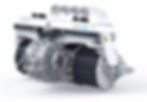Rimac Nevera - What the F*** !
- Ishaan Bharadwaj
- Jun 4, 2021
- 6 min read
'RIMAC' the electric techonology specialists from Croatia (It is a European country you geography back benchers) have been making massive news in the world of hypercars, specially when they were testing their concepts 1 and 2. They have finally unveiled the production version of their C_Two ( or Concept Two) and are calling it the 'Nevera' which mean Refrigirator in Spanish, I translated it on Google.

But never have I heard of a Refrigirator that has 1914 bhp and goes 415 km/h ( 258 mph ) and sets you back €2 Million, that's about ₹17.67 Crores plus custom duties and other shenanigans. The Nevera is the production-ready iteration of the Rimac C_Two concept car, which was revealed at the International Geneva Motor Show in 2018. Since then, Rimac's engineers have refined their new flagship on every level during an extensive development program, in the pursuit of the most outrageous electric hypercar driving experience. With the majority of key components of the Nevera developed in-house at Rimac's HQ in Croatia, all systems have been improved and enhanced since the initial prototypes to deliver on the higly-ambitious performance targets set for at the beginning of the project in 2018.

"This is it. This is the car I had in mind when I embarked on the 'impossible' journey ten years ago. All our hard work has resulted in the the Nevera - our record-breaking hypercar. This car was born to outperform, and to raise the bar, redefining the norm for performance cars. And not only in performance - but as an all-arround package. When we first revealed the C_Two, we set our targets extremely high. There was nothing else that could even come close to matching the car's cutting-edge electric powertrain and extreme performance. But for us, that was only the starting point," explains Mate Rimac, Founder and CEO of Rimac Automobili.

"Everyone at Rimac is driven by curiosity and a desire to push things to the absolute limit. With its combination of everyday use and 1914hp performance, the Nevera proves what is possible when there are no restraints placed on technology, development, or ambition. We have now unveiled a car that pushes the hypercar market to a higher level, we have utilized the full potential of the electric powertrain today, proving what we've always been saying - that electric hypercar, in the form of the Nevera, is beyond exciting, and that is as thrilling on the track, as it is cosseting crossing continents. We will be making just 150 examples of the Nevera, every single unit crafted in Croatia from passion and admiration for cars."

Nevera's groundbreaking monocoque, developed by the former C_Two Chief Engineer Daniele Giachi, includes a bonded carbon roof, integrated structural battery pack and rear carbon subframe, is forming the largest single carbon fibre piece in the entire automotive industry. Weighing less than 200kg and utilising 2200 carbon fibre plys and 222 aluminium inserts, the monocoque encases the car's battery to form a compact yet incredibly strong structure with a torsional stiffness of 70.000 Nm/degree. The level of unmatched strength and safety this provides has contributed to the Nevera meeting strict global homologation standards, and delivering the most rigid structure of any car ever made.

The key to the Nevera's exceptional performance is Rimac's pioneering electric powertrain. Every component of the Nevera's electric powertrain has been exhaustively reworked since its inception to deliver more torque, greater performance and enhanced efficiency.

The unique H-shaped, liquid-cooled, 120kWh, 6960-cell battery was designed from scratch by Rimac and sits at the very heart of the Rimac Nevera. Capable of producing 1.4MW of power, the Lithium/Manganese/Nickel battery also forms an integral part of the car's core, adding 37 per cent structural stiffness to the carbon fibre monocoque. The battery's optimum positioning low and central within the car's floor contributes to an ultra-low centre of gravity. This helps create an excellent 48/52 front/rear weight distribution and the best possible handling balance.

Developments of the advanced battery cooling system have made it even more efficient since the introduction of the C_Two, enabling more power to be delivered for greater periods. Four bespoke surface-mounted permanent magnet motors drive the Nevera's four wheels individually. Together, they enable 1914hp and 2360Nm of torque, which is triple the output of a 'conventional-engined' supercar. The front and rear wheels are each connected to a pair of single-speed gearboxes.

Capable of instantly summoning maximum torque from the first moment, the Nevera's electric motors are 97 per cent efficient - compared with 40 per cent for the most effective internal combustion engines - and completely maintenance-free throughout their operating life.
With the ability to sprint to 100 km/h in 1.85 seconds and continue the acceleration all the way to a 412 km/h (258mph) top speed, the Nevera opens up a new dimension in hypercar performance.

Accelerating from rest to 161 km/h (100 mph) requires just 4.3 seconds and it maintains its eye-widening acceleration throughout a full-throttle cycle, achieving 186mph (300 km/h) from rest in 9,3 seconds, shredding a whole 2,5 seconds from the initial targets. Finally, it achieves a record-breaking 8,6 seconds quarter-mile time.
Rimac's All-Wheel Torque Vectoring 2 (R-AWTV 2) system replaces traditional Electronic Stability Program and Traction Control systems to further bolster grip and traction. Meanwhile, the Rimac Nevera's R-AWTV 2 system enables infinitely variable dynamic responses to road and track conditions by calibrating the amount of torque supplied to each wheel. R-AWTV 2 calculates the precise level of torque to channel through each wheel for ultimate stability and exceptional agility. Both predictive and responsive, R-AWTV reads the road and makes over 100 calculations per second to tailor the level of torque to achieve the desired driving style.

"Our torque-vectoring enables new level of drivetrain calibration," explains Miroslav Zrnevi, Rimac Test and Development Driver, and depending on the driving mode selected, the R-AWTV 2 technology can enable the Nevera to be drifted sideways or provide optimum levels of all-wheel-drive grip, traction and safety - no matter how challenging the road and weather conditions.Thanks to a four-individual-motor drivetrain, the driver can also change the torque distribution, and personalize the performance delivery even further, for a completely bespoke drive - ranging from front to rear wheel drive biased car. "

The Nevera is also equipped with cutting-edge braking technology. A complex electro-hyrdaulic brake booster with brake pedal feel simulator distributes the braking force between the friction brakes and electric powertrain, depending on the battery, powertrain and brake state. For instance - it dissipates kinetic energy through the friction brakes if the battery is close to its thermal limits, or activates more regenerative braking in case the friction brakes are hot. All those transitions should remain in the background, not noticeable to the driver. This enables the Nevera to make the highest use of regenerative braking of any other car on the market now. In addition to a maximum range-enhancing regenerative braking of 300 kW provided by the electric motors, substantial stopping power comes from 390 mm Brembo CCMR carbon-ceramic brake discs and six-piston callipers. Combined they provide consistent, fade-free and exceptionally powerful braking, even when the car is subjected to extreme forces on the track.

With space for two occupants in full race regalia and their luggage, Nevera is as much a capable grand tourer as it is a performance hypercar. Digital screens soak up needless toggles and switches, leaving only essential tactile controls, giving more space to enjoy Rimac Nevera's carefully designed interior.

The cockpit features a trio of high-definition TFT screens, which present as much, or as little, information as the user requires. Configured for both track driving and comfort, the layout of the cockpit is divided into two zones. The focus of the top segment is entirely placed on driving pleasure and performance, while the lower part houses the infotainment system, comfort controls and driving data

Tactile billet aluminium rotary controls and switches - including three displays with rotating control - provide a resolutely analogue feel, tailored to enable the driver to utilise the cutting-edge digital technology in an even more engaging manner. From the cockpit, the driver can monitor every aspect of the car's performance with real-time telemetry - downloadable to a laptop or smartphone for later review.
The Rimac Nevera is too good to be true, I really feel the era of petrol powered hypercars is dimishing faster than we think. 1914 bhp is more than what we could dream of so soon. The best part is, it'll be cheap as chips to run. Install a big ass solar plant in your backyard and you'll technically be slaying Bugatti Chirons and Koeingseggs for FREE! What the F*** !





